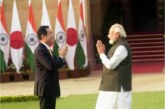[Undoubtedly relations between India and Russia are cordial but they lack the warmth that once pervaded Indo-Soviet relations. Dismantling of the erstwhile Soviet union, end of the Cold war, Russia’s own domestic and global problems and new Russian leadership’s approach to deal with the changing scenario to ensure its national interests coupled with facts of geopolitical challenges being faced by India and its growing economic clout and coming closer to Western countries, including the united sates, have been determining factors impacting upon the course of Indo-Russian relations in general and defence cooperation between the two countries in particular, Ed.]
Russia, which emerged as the successor state to the erstwhile Soviet Union, had inherited the rich legacy of warm and friendly Indo-Soviet relations, particularly during the heydays of the Cold War. However, in the post-Cold War, both India and Russia were placed in new configuration of forces both at the global and regional levels. The new geopolitical ground realities had their own peculiar compulsions and constraints within which both had to deal with new challenges and opportunities. It is noteworthy that former Soviet Union constituted a sole supplier of about India’s 80 per cent defence requirements, meeting India’s needs in critical areas of supplies like missiles, combat aircraft, submarines and other weaponry, including their spare parts.
However, Russia’s defence dealings with India have lacked in warmth that once characterized Indo-Soviet relations. Geopolitical constraints and compulsions being confronted by New Delhi and Moscow dictate the course of action to be pursued by each side. Moscow’s approach s being determined by the forces of the market and India looks for latest and state-of-art weapons while paying the market price. Besides, India is interested in upgrading the predominant buyer-seller relationship between India and Russia in the defence sector to a new level of joint partnership for co-developing state-of-the-art future weaponries.
This was amply demonstrated in Indian Prime Minister Dr Manmohan Singh’s recent two-day visit to Russia. As a sequel to reports of a new chill in the bilateral ties, particularly after Russian Foreign Minister Sergey Lavrov failed to meet his Indian counterpart Pranab Mukherjee during latter’s visit to Moscow recently, Indian Defence Minister A K Antony’s October visit to Russia just after it, gave a new boost to the bilateral ties. Both countries decided to co-develop and produce the Fifth Generation Fighter Aircraft (FGFA) during Antony’s visit.
Prime Minister Manmohan Singh’s visit to Moscow in November is expected to iron out differences on defence deals between Russia and India and the latter is likely to acquire nuclear-powered Akula-II submarines from Russia on a lease for 10 years.1 The deal, which could be worth over Rs 2,000 crore, or 508 million US dollars, would help the Indian Navy to fill the vacuum till India’s indigenously developed nuclear submarines are inducted. At present, the total cost of different acquisitions of military hardware and equipments from Russia is estimated to be around 10 billion dollars, which could rise after India accepted Russian demand of increasing escalation rate to five percent from 2.8 percent as earlier agreed between the two countries.
This is apart from the latest decision by the two countries to co-develop the FGFA by 2015, which would be equally financed by India and Russia, and it is estimated to cost approximately another 10 billion dollars. The next phase of bilateral defence ties, which many term as a ‘time-tested’ one, would focus on joint development and manufacture of new defence equipments that would include Multi-Role Transport Aircraft, and a new version of Brahmos cruise missile.2
In view of rapid strides recorded by India’s indigenous manufacturing industries and a new Defence Procurement Policy already giving emphasis on enhanced offsets, New Delhi seems to be keen to get rid of ‘one of the largest defence equipment buyer’ tag, and wants to indigenously as well as jointly develop technologies with other countries, particularly with Russia since the bilateral defence ties date over three decades. New India is also encouraging Moscow to induct the jointly developed supersonic cruise missile Brahmos. A positive signal from Russia would go a long way in strengthening defence cooperation between the two countries.
At this juncture, as the situation obtains, Russia is legally bound to induct only those weapon systems that have been indigenously developed by them, and Brahmos being a joint venture of India and Russia, is unlikely to be inducted by Russia. According to India’s Defence Research and Development Organization (DRDO) sources, Russia may be willing to induct Brahmos missiles, which are considered technically superior than American cruise missiles.
Situation in the 1990s and early years of the first decade of the new millennium had remained favourable to Moscow. Even as the United States, Britain, Israel, France, South Africa and other countries were anxiously eyeing the burgeoning multi-billion dollar Indian defence market, Russia was confident that its long-standing strategic relationship with India would continue to make progress. A visiting Russian delegation told the media persons in New Delhi on 21 April 2002 that Moscow and New Delhi were negotiating several ambitious projects for joint development and production of weapon systems. Several deals, including the ones for aircraft carrier admiral Gorshkov and the Tu-22m3 long-range strategic bombers, were in the pipeline.
Victor M. Komardin, deputy director-general of Russia’s state-owned weapon supplier Rosoboron Export, had told the Times of India on 21 April 2002: ‘‘We are certainly not worried about the competition…we know our positive and negative points.”3 Practically all major contracts between the two countries had provisions for licensed production in India. The focus in the future was likely to shift to joint development, production and the sale of high-tech weapon systems. The Brahmos supersonic cruise missile was one such project. Discussions were also on for co-development of a 100-seater multi-role transport aircraft and a fifth-generation combat fighter.
Irkut (Sukhoi) corporation chief, Alexei Fedorov, had reportedly proposed a strategic partnership with Hindustan Aeronautics Limited to jointly corner a share of the world aerospace market. Towards this end, Russia wanted New Delhi to take part in developing Sukhoi jets for Malaysia as they would basically be ‘derivatives’ of the Su-30Mkis being manufactured for India. Russia also seemed keen to sell a whole range of military hardware and software to India.
Strains in Ties
However, Indo-Russian relations, including defence ties seemingly took a beating during 2006 as new and disturbing trends emerged in relations that could have long-term negative consequences for New Delhi. A sense of apprehension in the Kremlin and South Block prompted President Vladimir Putin and Prime Minister Manmohan Singh to set up a joint study group this year to give fresh impetus to bilateral trade.
The JSG’s first meeting in Moscow in August, however, witnessed its Russian co-chair Mikhail Dmitriyev conceding that Russian businessman preferred to do business with Europe, ‘where his children study and where he spends his vacations’. Fifteen years after the break up of the Soviet Union and after signing several declarations and partnership pacts, New Delhi and Moscow failed this year to translate their political trust into tangible results in economic interaction and trade.
Defence ties, the cornerstone of Indo-Russian friendship, too suffered a major dent when anonymous experts attacked Brahmos Aerospace, the Indo-Russian cruise missile joint venture in a government news agency commentary and spoke against such new projects on which India has been pinning hopes to acquire cutting-edge futuristic weapons and platforms.
Experts said it was becoming increasingly evident that India had failed to see the winds of change sweeping buoyant Russia and adjust its energy policy accordingly. According to some experts, the pragmatism of the Russian leadership was overwhelming and old ideological guidelines had become a passé. Putin’s Russia, awash in petro-dollars, could not be taken for granted any more.4
President Putin’s Visit to India
Russian President, Vladimir Putin’s visit to India on 25-26 January 2007 provided fresh momentum to the strategic partnership between New Delhi and Moscow. The visit reinforced the interests of both states in maintaining their traditionally close and friendly relationship and in strengthening a multipolar world order. The underlying objective of President Putin’s visit to India was to bring warmth that was fast turning into chill in recent times.
Ever since India and the US signed the nuclear deal, some quarters had perceived that India was inclining more towards the US and that consequently the Indo-Russian relationship would be strained. But Putin’s visit and acceptance of the Indian government’s invitation to be the chief guest at the Republic Day celebration seemed to have diluted much of these incorrect perceptions. It is noteworthy that Russia has never imposed any sanctions on India, nor has it provided arms to Pakistan. Furthermore, Russia warned China in 2006 not to install Russian made RD-93 jet engines in the fighter aircraft that China was jointly developing with Pakistan.5 Although differences arise over certain issues on certain occasions; the overall parallelism in the Indo-Russian relationship definitely symbolizes the trust that still exists between them.
During his January 2007 visit to India, Russian President stated that there could be no effective cooperation without political support, and suggested that the high level of political trust between the two countries needed to be translated into economic co-operation. He also articulated the point that both countries being market-oriented economies, needed to make greater efforts to conquer each other’s markets.
Apart from Brahmos missile, the joint development of multi-purpose transport planes is another significant feature of the evolving relationship between the two countries. Other important features of Indo-Russian defence co-operation include the Admiral Gorshkov aircraft carrier, which will join the Indian Navy as the INS Vikramaditya after a full refit by the end of 2008, and deliveries of MiG-29 which will take place by the end of 2007. Of late, Russia has also advanced a proposal for selling the advanced Mig-35 fighter jet to the Indian Air Force. All these indicate that Russia will maintain an edge over other countries in supplying military hardware to India’s defence sector.
Initial talks on developing a hypersonic version of the Brahmos cruise missile are taking place between the two countries, and efforts are on to make the transition from planning stage to implementation stage of developing such missiles. The hypersonic missiles would approximately move five times faster than the present cruise missile. The present supersonic Brahmos cruise missile, which can be launched from any platform, can attain the speed of Mach 2.8 (2.8 times the speed of sound) and is about three times faster than the subsonic US’ Tomahawk cruise missile. Though the range of Brahmos at present is close to 300 km, it is quite logical that hypersonic version would have longer range.
Irritants
However, recent experience on acquisition of defence equipment from Russia has not been very smooth. The bilateral defence ties have been marked by some irritants like delays, sometimes indefinite, revision of costs etc., which serve as a stumbling block in the smooth growth of defence ties. The classic example being the acquisition of 44,570-tonne aircraft carrier Admiral Gorshkov.
The aircraft carrier was originally expected to join Indian Navy by August 2008, but ‘unforeseen problems’ has cast a doubt that Russia would be able to stick to its deadline, since reports from Moscow suggest that lots of repairing work still remains to be done. The recent enhancement in the escalation rate is expected to inflate the cost of the aircraft carrier, which was initially signed as 1.5 billion dollars deal in


